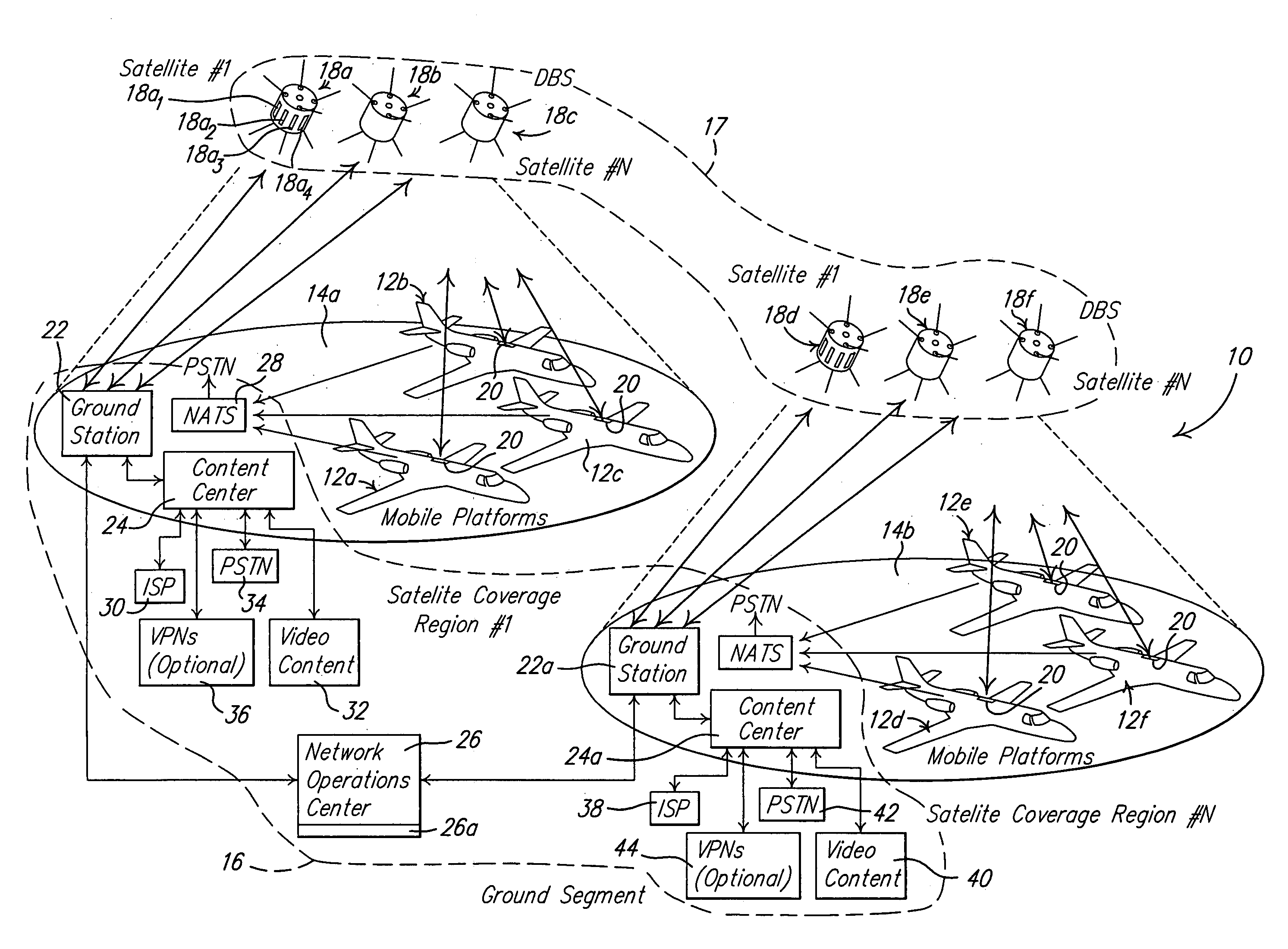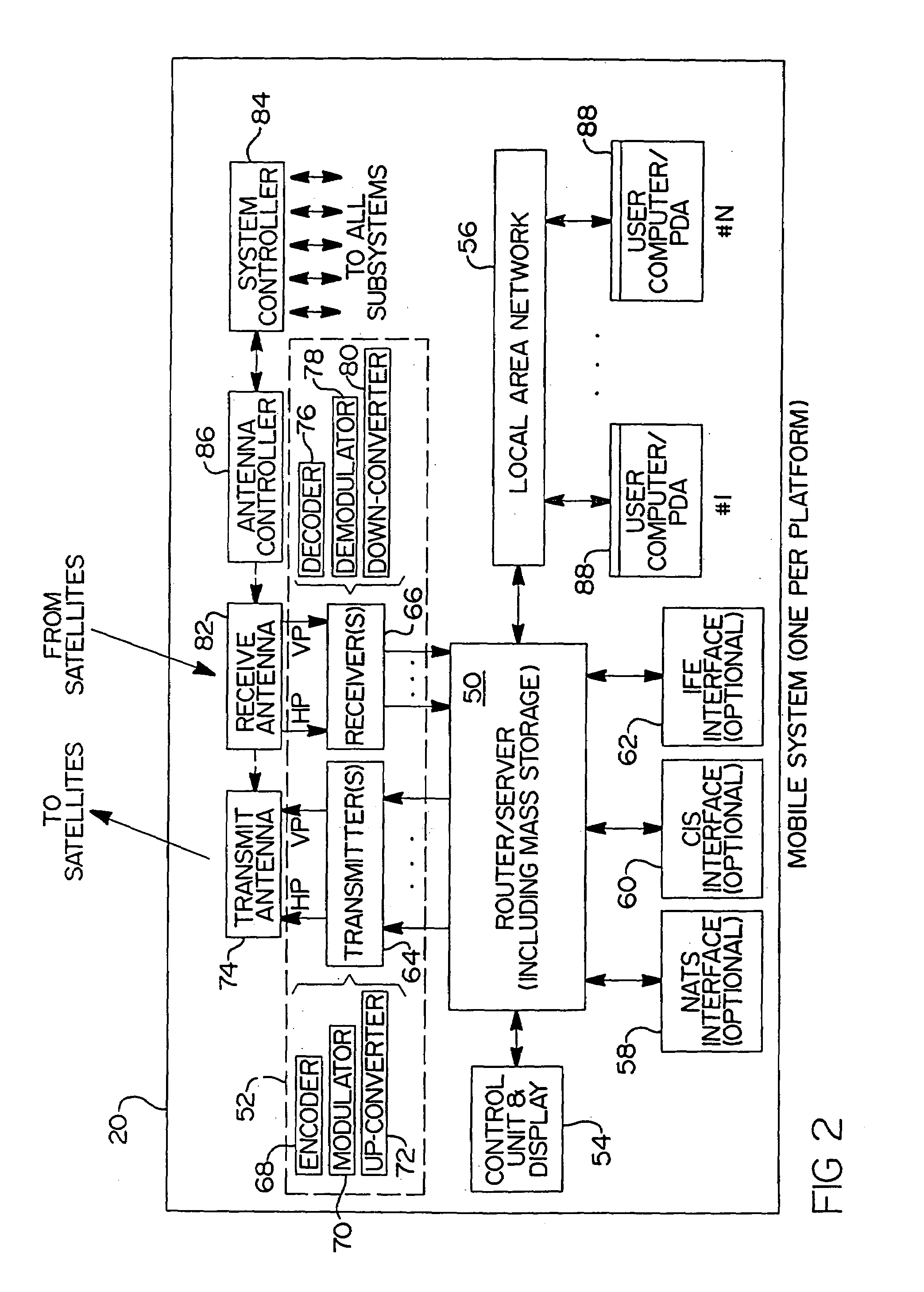Broadband data and video services, on which our society and economy have grown to depend, have heretofore generally not been readily available to users
on board mobile platforms such as aircraft, ships, trains, automobiles, etc.
While the technology exists to deliver such services to all forms of mobile platforms, past solutions have been generally quite expensive,
low data rate and / or available to only very limited markets of government / military users and some high-end maritime markets (i.e.,
cruise ships).
Previously developed systems which have attempted to provide live TV and data services to mobile platforms have done so with only limited success.
One major obstacle has been the high cost of access to such
broadband data and video services.
Another problem is the
limited capacity of previously developed systems, which is insufficient for mobile platforms carrying dozens, or even hundreds, of individuals who each may be simultaneously requesting different channels of
programming or different data services.
Furthermore, presently existing systems are generally not readily scalable to address the demands of the traveling public.
However, no system or method presently exists for providing high speed (i.e., greater than 64 Kbps) data networking services to groups of users on mobile or remote platforms, let alone for providing such high-speed networking services together with video services.
These systems are very limited in their link capability (primarily use communication links developed for
telephony) and the service is very expensive (greater than about $1.00 per minute for voice connection).
For these reasons, and in view of adherent limitations on the capacity of such systems, such systems have met with limited commercial success and acceptance.
These connection forms have several drawbacks:1) a limited connection bandwidth (typically less than 64 Kbps);2) limited overall
system capacity (due to limited
frequency spectrum); and3) high expense.
Inmarsat operates in the L-band
frequency spectrum, where there is very little bandwidth and capacity available for providing
broadband services to the traveling public.
NATS based solutions (i.e., GTE Airfone, AT&T Claircom), familiar to domestic airline travelers who use seat back-mounted telephones, also provide very
limited capacity because of operation at L-band.
These systems also suffer from the additional problem that
connectivity is only available over land.
Current mobile platform connection methods are inherently
narrow band and
restrict the flow of data to the point where common networking tasks are impossible.
With
present day systems which attempt to provide a means by which a plurality of mobile platforms transmit data to a shared satellite-based transponder, a particularly troubling problem has been how to efficiently operate and manage a plurality of small aperture mobile transmitting terminals that are geographically distributed over a
wide area, with each mobile terminal transmitting at a different power
spectral density (PSD) level according to its specific aperture size, the location of the mobile platform and the
data rate at which data is being transmitted.
Also, mobile transmit antennas can interfere with communications on satellites in non-geostationary orbits (NGSOs).
Put differently, such mobile transmit antennas can easily produce signals that interfere with the operation of GSO and NGSO satellites that are adjacent to the target satellite.
When a plurality of mobile platforms are transmitting RF signals to a common transponder within a given coverage region, it becomes very difficult to manage the PSD of individual mobile platforms to ensure that the “aggregate” PSD never exceeds the regulatory limits, while simultaneously attempting to maximize the total number of mobile platforms accessing the transponder.
This method of operation is wasteful of PSD because the unused PSD in each channel cannot be used.
Furthermore, MCPC cannot be adapted to efficient PSD operation because
channel management becomes prohibitively complex, especially for applications using mobile terminals.
Similarly,
time division multiple access (TDMA) methods have only one terminal accessing a channel or time slot at any time so that the available channel PSD is fixed and usually exceeds the requirements of the channel user.
Therefore, PSD is wasted and cannot be reused.
With these previously developed methods, individual accesses do not usually occur at the maximum allowable PSD, so that there will usually be some amount of PSD that is unused or wasted in every channel.
This is the primary drawback of all previously developed methods.
The above described scenarios where only one terminal is transmitting within a channel or time slot at any given time thus present the classic problem of allocating a fixed size resource (i.e., PSD) to variable sized users.
The fixed size resource must then be sized for the worst case (i.e., maximum PSD) user so there will always be inefficiency with these approaches.
If the variations between users is small, then the inefficiency can be reasonably low, but for any other application where there are large differences in user PSD requirements, the inefficiency becomes substantial.
With this method of operation there are statistical variations in PSD levels and interference between users that would be unacceptable for high-quality
satellite data communication systems.
 Login to View More
Login to View More  Login to View More
Login to View More 


